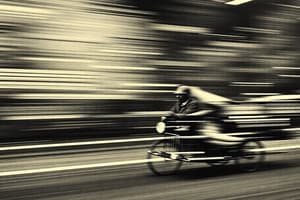Podcast
Questions and Answers
What is the difference between speed and velocity?
What is the difference between speed and velocity?
- Speed is a scalar quantity while velocity is a vector quantity.
- Speed and velocity are the same thing.
- Velocity considers direction while speed does not. (correct)
- Speed considers direction while velocity does not.
If an object is moving at a constant speed in a circular path, what can be said about its velocity?
If an object is moving at a constant speed in a circular path, what can be said about its velocity?
- Its velocity is changing continuously. (correct)
- Its velocity is zero.
- Its velocity is the same as its speed.
- Its velocity is constant.
What is the formula for calculating acceleration?
What is the formula for calculating acceleration?
- Acceleration = final velocity / initial velocity
- Acceleration = (final velocity - initial velocity) / total time taken (correct)
- Acceleration = final velocity - initial velocity
- Acceleration = final velocity - initial velocity / total time taken
If an object is moving with a constant velocity, what can be said about its acceleration?
If an object is moving with a constant velocity, what can be said about its acceleration?
What is the difference between distance and displacement?
What is the difference between distance and displacement?
Flashcards are hidden until you start studying
Study Notes
Motion is defined as a change of position, shape, size or orientation over time. Describing motion involves understanding several key concepts such as distance, displacement, speed, velocity, and acceleration. Each of these aspects plays a crucial role in comprehending how objects move and behave, allowing us to predict their future positions and trajectories.
Distance
Distance refers to the total length that an object travels from its initial position to its final position, regardless of any changes in direction during the travel. For example, if you walk from your house to the local park, the distance traveled would be the straight line between those two locations, even if you took a roundabout route. This is often measured using units like meters or miles.
Displacement
Displacement describes the relative position change of an object from one location to another. It's essentially a measure of how far away from the starting point an object has moved. If you start walking towards the east and then turn around and start walking back westwards, your displacement would be zero because you returned to your original position.
Speed
Speed is a scalar quantity that represents the rate at which an object covers a certain distance without considering the time taken to do so. It can be calculated by dividing the distance covered by the time it takes to cover that distance. For example, if you walk 1 kilometer in 1 hour, your average speed would be 1 kilometer per hour.
Velocity
Velocity is similar to speed but takes into account direction as well. It can also be described as the rate at which an object changes its displacement over time. If you are moving northwards at 10 meters per second and then suddenly change course to move westwards, your velocity has changed even though your speed remains constant. The magnitude of velocity is equal to speed, while the direction indicates your motion relative to others around you.
Acceleration
Acceleration describes how rapidly an object increases or decreases its velocity over time. It acts on objects due to forces like gravity, whether the object is accelerating or decelerating. An object will continue to keep moving with constant acceleration until acted upon by another force. Acceleration is calculated using the formula: final velocity - initial velocity / total time taken for acceleration.
In summary, describing motion involves understanding the distance traveled, the displacement from the starting point, the speed at which the motion occurred, and how quickly the velocity changed over time due to acceleration. These concepts form the foundation of our ability to predict and understand the behavior of moving objects around us.
Studying That Suits You
Use AI to generate personalized quizzes and flashcards to suit your learning preferences.




